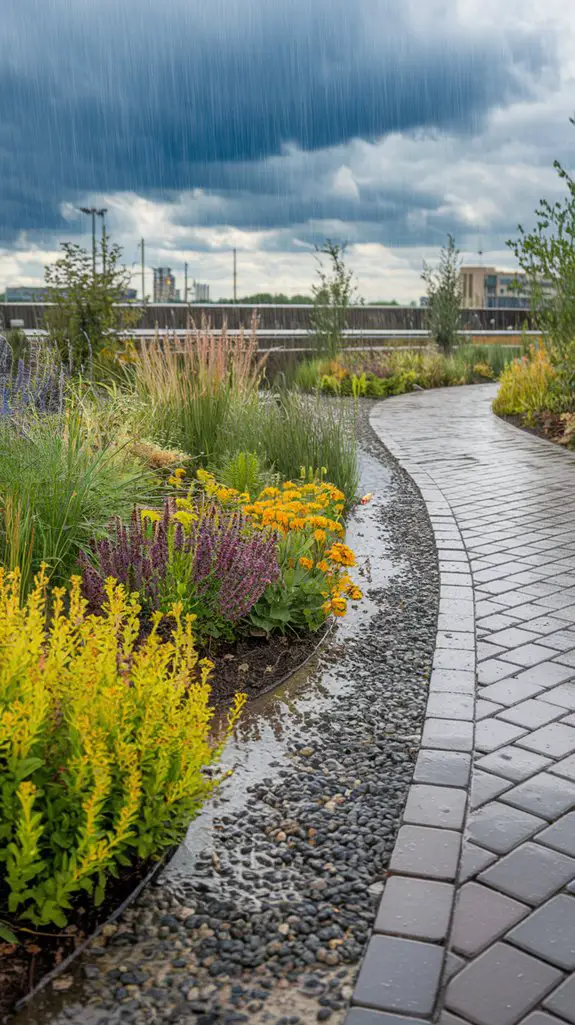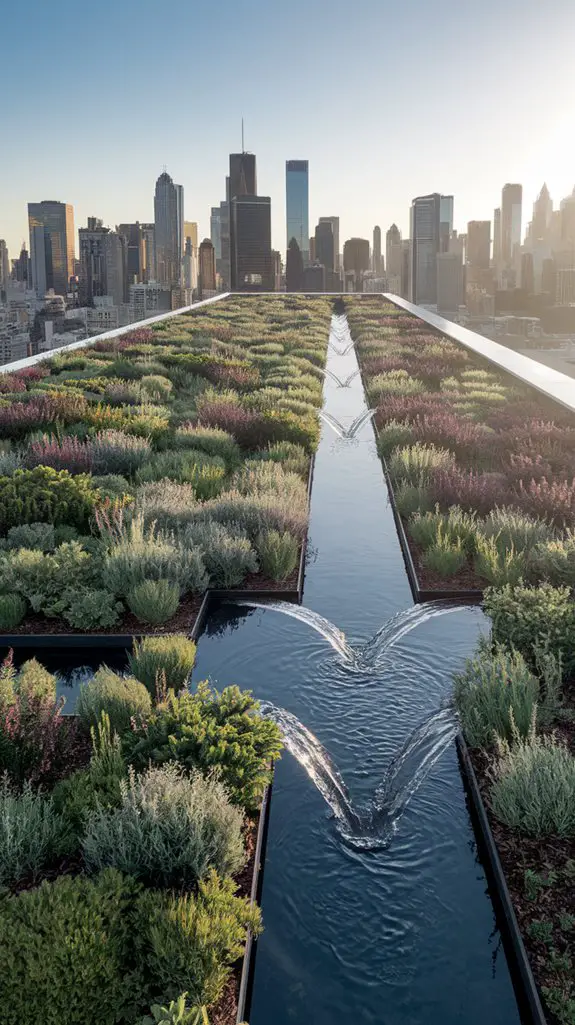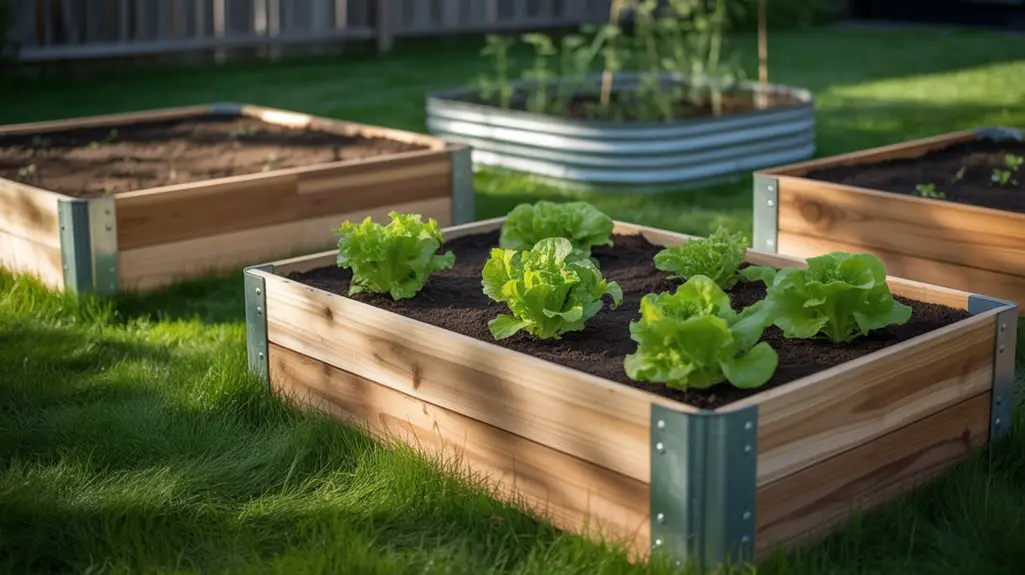Just as ancient civilizations thrived by mastering water collection in harsh climates, you can transform your property’s sustainability through intelligent rainwater harvesting. When you implement eco-friendly collection systems, you’ll reduce your water bills while protecting local watersheds from harmful runoff. Modern harvesting methods range from simple DIY solutions to sophisticated systems that integrate with your existing landscape. Ready to discover which of these five approaches might work best for your specific needs?
Rain Barrels: Simple Collection for Garden Irrigation
One of the most accessible entry points into rainwater harvesting is the installation of rain barrels, which can collect up to 50 gallons of water from a typical rainfall event.
You’ll need to place these containers beneath downspouts, where water naturally flows from your gutters.
For ideal functionality, install a mesh screen to filter debris and prevent mosquito breeding.
Most systems include an overflow valve that redirects excess water during heavy rainfall.
You can enhance your setup with a first-flush diverter that channels initial runoff—which typically contains contaminants—away from your collection barrel.
When irrigating, connect a soaker hose to the spigot at the barrel’s base to utilize gravity for water distribution.
For multi-barrel systems, consider linking units with connectors that equalize water levels, effectively increasing your storage capacity. Additionally, rainwater systems can significantly reduce your reliance on municipal water sources, making it a sustainable choice for eco-conscious homeowners.
Permeable Surfaces and Rain Gardens for Natural Filtration

Beyond traditional collection methods, implementing permeable surfaces and rain gardens offers a sophisticated approach to rainwater management that mimics natural hydrological processes.
These solutions reduce runoff, prevent erosion, and naturally filter contaminants before water reaches groundwater supplies.
- Use permeable pavers for driveways and walkways to allow water infiltration while maintaining structural integrity.
- Design rain gardens with native plants in shallow depressions where runoff naturally collects.
- Layer your rain garden with gravel, sand, and specialized soil mixes to enhance filtration capacity.
By utilizing rainwater collection methods, you can create a more sustainable garden ecosystem that thrives on naturally sourced water.
You’ll see multiple benefits from these systems—reduced flooding risks, decreased water pollution, and enhanced landscape aesthetics.
The initial installation requires planning and some investment, but the long-term environmental returns greatly outweigh these costs.
Green Roof Systems That Capture and Purify Rainfall

Green roof systems represent another tier of innovation in rainwater management, literally elevating your harvesting capabilities to unused structural spaces. These living installations filter pollutants through layers of vegetation and substrate while reducing runoff by up to 90%. Additionally, utilizing sustainable building materials for the installation can further enhance the environmental benefits of your project.
| System Type | Benefits | Implementation Complexity |
|---|---|---|
| Extensive | Low maintenance, lightweight | Moderate |
| Intensive | Greater water retention, biodiversity | High |
| Modular | Easy installation, scalable | Low |
You’ll need to take into account structural load capacity before installation, typically requiring 15-30 pounds per square foot for extensive systems. Most effective designs incorporate water-retention layers beneath growing media to maximize storage. Modern green roofs integrate with downspout systems, allowing excess filtered water to feed into conventional storage tanks for household use, creating a thorough closed-loop system.
DIY Gravity-Fed Drip Irrigation From Collected Rainwater
A gravity-fed drip irrigation system represents one of the most efficient applications for harvested rainwater, offering you a practical way to utilize collected precipitation without requiring electricity or complex technology.
To create this system, you’ll need to position your rain barrel at least 2 feet higher than your garden beds to generate sufficient water pressure.
- Connect microtubing from the elevated container to emitters strategically placed near plant roots, delivering water precisely where needed.
- Install a basic filtration system using mesh screens to prevent clogging of emitters with debris.
- Incorporate a timer valve or float system to regulate water flow based on soil moisture levels.
This approach can reduce your water consumption by up to 70% compared to conventional irrigation methods while simultaneously improving plant growth through consistent moisture delivery. Additionally, utilizing rainwater collection barrels can further enhance your sustainability efforts by maximizing the use of natural resources.
Underground Cisterns for Large-Scale Water Conservation
Underground cisterns represent a significant advancement in rainwater harvesting technology, enabling property owners to store substantially larger volumes of water than conventional above-ground systems. You’ll find these subterranean tanks particularly valuable during extended dry periods when water conservation becomes critical. Additionally, these systems contribute to sustainable water management, promoting a more eco-friendly approach to handling stormwater runoff.
| Cistern Type | Capacity Range | Best Application |
|---|---|---|
| Concrete | 5,000-15,000 gal | Permanent structures |
| Polyethylene | 1,500-5,000 gal | Retrofits & flexibility |
| Fiberglass | 3,000-10,000 gal | Corrosion resistance |
When installing an underground cistern, you’ll need to take into account soil stability, water table depth, and access requirements for maintenance. Professional installation guarantees proper filtration systems and pump configurations. The initial investment typically ranges from $5,000-$15,000, but you’ll achieve significant long-term savings through reduced municipal water usage and stormwater management fees.
Conclusion
By implementing these five rainwater harvesting methods, you’ll greatly reduce municipal water consumption while supporting healthier ecosystems. Though initial installation costs may seem prohibitive, each system delivers substantial ROI through reduced utility bills and increased property values. Analyze your specific precipitation patterns and space constraints to determine which combination of systems provides ideal water capture efficiency for your location’s unique requirements.




